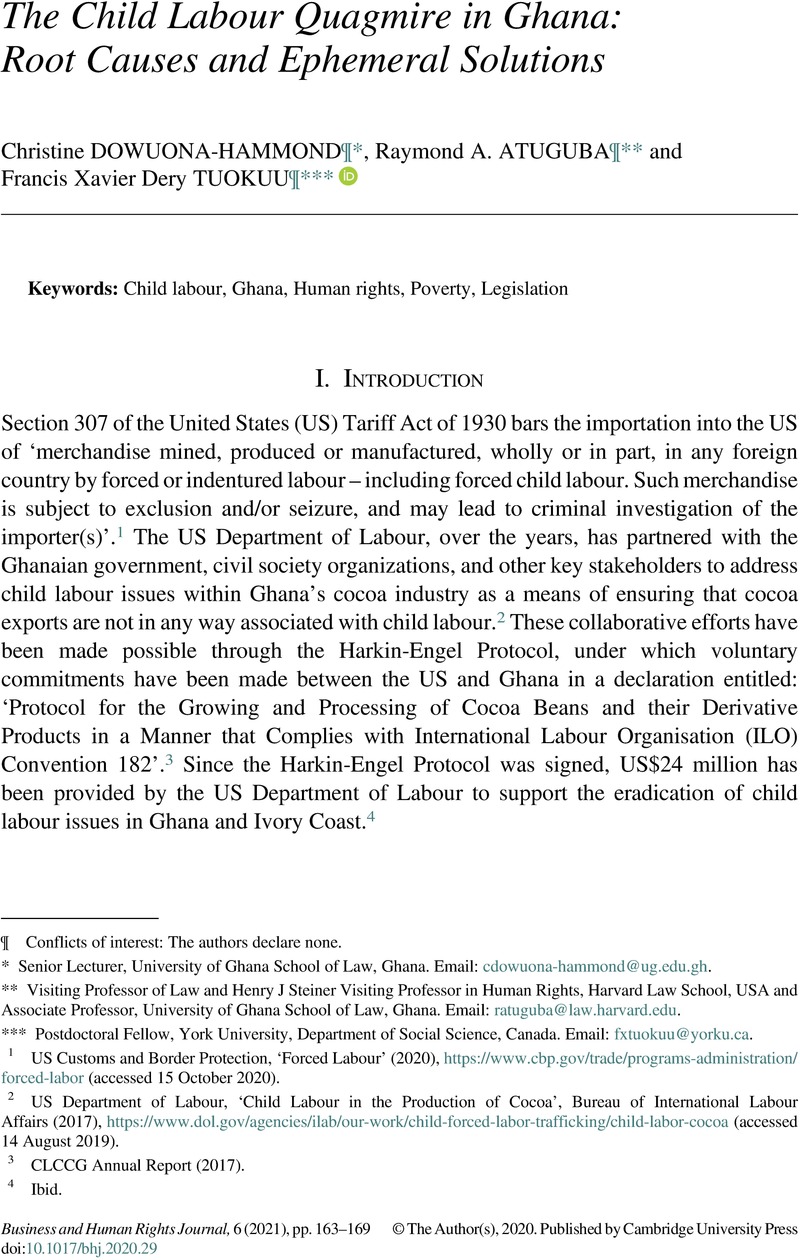Published online by Cambridge University Press: 17 December 2020

Conflicts of interest: The authors declare none.
Senior Lecturer, University of Ghana School of Law, Ghana. Email: [email protected].
Visiting Professor of Law and Henry J Steiner Visiting Professor in Human Rights, Harvard Law School, USA and Associate Professor, University of Ghana School of Law, Ghana. Email: [email protected].
Postdoctoral Fellow, York University, Department of Social Science, Canada. Email: [email protected].
1 US Customs and Border Protection, ‘Forced Labour’ (2020), https://www.cbp.gov/trade/programs-administration/forced-labor (accessed 15 October 2020).
2 US Department of Labour, ‘Child Labour in the Production of Cocoa’, Bureau of International Labour Affairs (2017), https://www.dol.gov/agencies/ilab/our-work/child-forced-labor-trafficking/child-labor-cocoa (accessed 14 August 2019).
3 CLCCG Annual Report (2017).
4 Ibid.
5 Government of Ghana (2003), Ghana Poverty Reduction Strategy: 2003–2005; Government of Ghana (2010), Medium-Term National Development Policy Framework: Ghana Shared Growth and Development Agenda (GSGDA), 2010–2013; Government of Ghana (2014), Ghana Shared Growth and Development Agenda (GSGDA) II, 2014–2017.
6 ILO-IPEC (2017), Global Estimates of Child Labour: Results and Trends, 2012–2016, Geneva, p 11. See also ILO-IPEC (2013), Marking Progress Against Child Labour – Global Estimates and Trends 2000–2012, Geneva, p vii, which put the number of children in child labour at 161 million.
7 Inter-Agency Country Report (ILO, UNICEF, World Bank) Child Labour and the Youth Decent Work Deficit in Ghana, February 2016, p 16.
8 Ghana Statistical Service, Ghana Living Standards Survey Round 6 (GLSS 6) Child Labour Report, August 2014.
9 Ghana Statistical Service, Ghana Child labour Survey, 2003 (GCLS, GSS 2003).
10 Ghana Statistical Service, Ghana Living Standards Survey Round 6 (GLSS 6) Child Labour Report, August 2014.
11 Ghana Statistical Service, Ghana Child labour Survey, 2003 (GCLS, GSS 2003).
12 Ibid.
13 Inter-Agency Country Report (ILO, UNICEF, World Bank) Child Labour and the Youth Decent Work Deficit in Ghana, February 2016, p 16; Peter Fallon and Zafiris Tzannatos, Child Labour – Issues and Directions for the World Bank, 1997; UNICEF, Situation Analysis of Children and Work in Ghana, 2000; Bureau of International Labour Affairs, 2016 Findings on the Worst Forms of Child Labour.
14 Children’s Act, 1998 (Act 560), s 89.
15 International Labour Organisation, ‘C182 – Worst Forms of Child Labour Convention, 1999 (No. 182)’, https://www.ilo.org/dyn/normlex/en/f?p=NORMLEXPUB:12100:0::NO::P12100_ILO_CODE:C182 (accessed 6 November 2020).
16 US Department of Labour, ‘Child Labour in the Production of Cocoa’, Bureau of International Labour Affairs (2017), https://www.dol.gov/agencies/ilab/our-work/child-forced-labor-trafficking/child-labor-cocoa (accessed 14 August 2019).
17 Berlan, Amanda, ‘Child Labour in Cocoa: Whose Voices Prevail?’ (2009) 29 The International Journal of Sociology and Social Policy 141–151.CrossRefGoogle Scholar
18 Ibid.
19 The Guardian, ‘Aboard the Slave Ship of Despair: Traffickers Buying the Young in West Africa’ (2001), https://www.theguardian.com/world/2001/apr/16/chrismcgreal (accessed 6 November 2020).
20 US Department of Labour, ‘Child Labour in the Production of Cocoa’, Bureau of International Labour Affairs (2017), https://www.dol.gov/agencies/ilab/our-work/child-forced-labor-trafficking/child-labor-cocoa (accessed 14 August 2019).
21 US Department of Labour, ‘Child Labour in the Production of Cocoa’, Bureau of International Labour Affairs (2017), https://www.dol.gov/agencies/ilab/our-work/child-forced-labor-trafficking/child-labor-cocoa (accessed 14 August 2019).
22 Berlan, Amanda, ‘Social Sustainability in Agriculture: An Anthropological Perspective on Child Labour in Cocoa Production in Ghana’ (2013) 49 Journal of Development Studies 1088–1100.CrossRefGoogle Scholar
23 Baah, Francis, ‘Use of Children and the Issue of Child Labour in Ghanaian Cocoa Farm Activities’ (2010) 2:9 Journal of Agricultural Extension and Rural Development 198–204.Google Scholar
24 Baah, Francis, ‘Cocoa Cultivation in Ghana: an analysis of farmers’ information and knowledge systems and attitudes’. PhD Thesis, Institute of International Development and Applied Economics, University of Reading, Reading, UK, 292 (2006).Google Scholar
25 Schrage, Elliot J and Ewing, Anthony P, ‘The Cocoa Industry and Child Labour’ (2005) 18 Journal of Corporate Citizenship 99–112.CrossRefGoogle Scholar
26 International Labour Organization (ILO), Combating Trafficking in Children in West and Central Africa, Synthesis Report Based on Studies of Benin, Burkina Faso, Cameroon, Cote d’Ivoire, Gabon, Ghana, Mali, Nigeria and Togo, 2001 at 5, http://www.ilo.org/public/english/standards/ipec/publ/field/africa/central.pdf (last visited on 10 June 2007).
27 Daily Graphic Report, 29 March 2005, No. 149389.
28 Protocol to Prevent, Suppress, and Punish Trafficking in Persons, Especially Women and Children, Supplementing the United Nations Convention Against Transnational Organized Crime, Report of the Ad Hoc Committee on the Elaboration of a Convention Against Transnational Organized Crime on the Work of its First to Eleventh Sessions, U.N. GAOR 55th Session, Agenda Item 105, U.N. Doc. A/55/383 (2000) (hereinafter the ‘Palermo Protocol’).
29 Ibid, art 3.
30 Ibid, art 2. See also Kelly Hyland, The Impact of the Protocol to Prevent, Suppress and Punish Trafficking in Persons, Especially Women and Children, 8 HUM. RTS. Q. 30 (2001).
31 Palermo Protocol, supra note 6, Preamble.
32 Bureau of International Labour Affairs, ‘Findings on the Worst Forms of Child Labour’ (2017), https://www.refworld.org/pdfid/5bd05ac616.pdf (accessed 12 November 2020).
33 [2004] 1 SCGLR 471.
34 Supreme Court of Ghana Law Reports (SCGLR) 547.
35 [1996–97] SCGLR 729. In this case, the Supreme Court accorded a corporate body the same status as a natural person in enforcing the fundamental rights enshrined in the 1992 Constitution of Ghana.